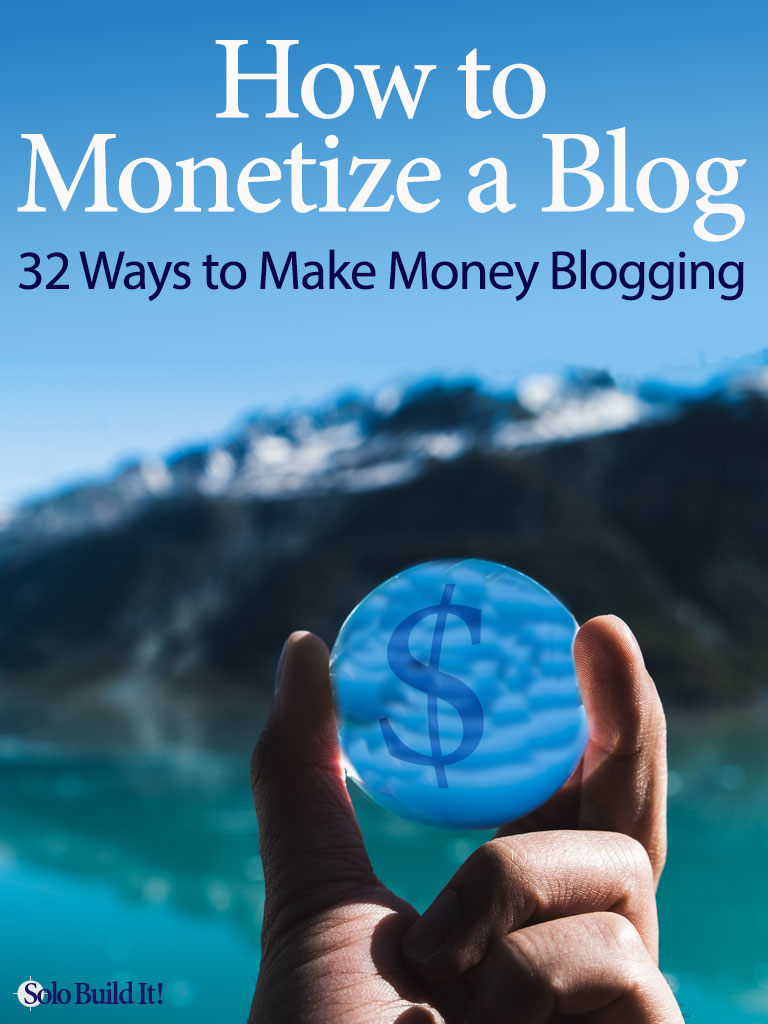
The toughest part of the blogging business is building an engaged audience. The good news is there are plenty of ways to monetize a blog once people start showing up every day.
In a world where more content is created than can possibly be consumed, our attention spans are shrinking. Getting people to stop, listen and then take action is no small feat.
When you’re on the right track promoting your website and building traffic, you’re ready to start thinking about how to get paid for your efforts.
Though with so many ways how to monetize your blog, it may not feel simple when you don’t know where to begin.
Here are 32 proven monetization strategies that can help turn your blog into a profitable business.
Monetize Your Website With Ads

Your online real estate is any web property that you own and control – like a blog or website using your own domain name and hosting you pay for.
Your Facebook Page and other social accounts don’t count. Neither do any of the “free” website-building platforms. You don’t own them, you have limited control over them, and you could be evicted if you fail to comply with the terms of your “residency.”
The more visitors your real estate attracts, the more valuable it is within your niche, and the more income you can generate through ads.
1. Display third-party ads on your blog.
With display ads, you get paid every time a user clicks on or views an ad.
Google’s AdSense program is the most popular solution. Others include Infolinks and Media.net.
2. Sell your own ad space.
Why give a chunk of your profits to Google when you can strike a deal with advertisers directly? It’s more work – work that could easily outweigh any increase in revenue. But if advertising is important to your business and you want to get more “hands on,” selling ads is worth investigating. Services like BuySellAds (for tech niches) make going it alone a little less lonely.
3. Attract site sponsors.
Sponsors pay you money to support your business (in exchange for a banner pointing back to their site).
In practical terms, there’s little difference between a regular display ad and an “ad” from a sponsor. As your site grows, potential sponsors may contact you directly. Or you can reach out to them once you have sufficient traffic to pique their interest.
4. Host surveys.
This won’t be for everyone, but may be worth trying. The idea? Hide the bulk of your content from users until they have completed a simple survey.
Once they have, they’re free to read the article, and you earn a few cents from Google. Visit Google Opinion Rewards for details.
5. Create a YouTube channel and show ads on videos embedded on your website.
Post videos to your channel, and when you meet YouTube’s minimum thresholds, apply to show ads before each video starts playing. It will take time and effort to reach the point where you’re allowed to have ads, so focus on some other monetization methods during the wait.
Embed the videos on your site’s pages, and you have the best of both worlds — content that engages people, and ad income.
Bottom line? Renting out your real estate is attractive because it’s “easy money” — no customers to deal with, no products to develop, no worries about tight margins.
On the flip side, income is rarely as large as publishers hope or expect (unless they have gazillions of visitors in a commercial niche). And it’s easy to make your site look tacky if you overdo it.
Get Paid for Blogging About Other People’s Products

When you recommend products and services as an affiliate, you normally receive a percentage of any sale (meaning if there’s no sale, you’re not compensated).
Affiliate recommendations are precisely that: recommendations. Because you put your reputation on the line with affiliate products, it’s crucial that you’re familiar with the products (and actually do recommend them!).
Familiarity also allows you to write about the product in an original and helpful way. So be original and seek to provide tremendous value. Then you’ll be on your way to succeeding as an affiliate marketer.
How do you find affiliate products to promote?
6. Sign up with an affiliate aggregator.
Aggregators bring together smaller companies with affiliate programs. This makes potential partners easier for you to find. You’ll also be paid faster, because commissions from different partners will go into the same pot, allowing you to reach the minimum payment threshold faster.
Popular aggregators include CJ Affiliate and ShareASale.
7. Be an affiliate for an online marketplace.
The “Big Two” are Amazon Associates and eBay Partners. Smaller marketplaces often have an affiliate program, too – here’s Etsy’s, for example.
8. Find individual companies in your niche with affiliate programs.
Many small companies use an aggregator, so you may have already found your ideal partner. If not, search for products in your niche and look for a link to an affiliate program on the website (it’s often in the footer). And search for “your niche” + “affiliate” (with the quotes) on your favorite search engine.
If you are in the travel niche, check out these popular travel affiliate programs.
9. Promote WordPress freemium themes and plugins.
If your blog is about blogging, you can make money with WordPress by promoting themes and plugins.
Here are two other ways to make money by promoting other businesses’ products…
10. Write about offline businesses for finder’s fees.
These are like the offline version of affiliate commissions. Let’s say you’re in the travel niche and you know a local boat charter company that doesn’t have an online presence to speak of.
Making money is simple: talk to the company owner or manager, face to face, and negotiate a percentage of any business you send their way.
11. Network marketing.
Also known as multi-level marketing (or MLM), this type of marketing receives a lot of bad press. Done right, though, it can be an excellent way to monetize.
In a nutshell, it involves reselling products from a supplier and recruiting salespeople to do the same. You receive compensation for the sales of everyone in your “downline.” If that sounds like it might be for you, this list of MLM companies is a good starting point.
Bottom line on being an affiliate? The more you put into it, the more you get out of it.
If you slap affiliate banners all over your site and expect to get rich, you’ll be disappointed (and you’ll make your site look spammy!). If you write engaging content and only recommend products from quality partners in appropriate places, you’ll do much better.
That said, you’ll still be a “middle man.” True, you won’t have to deal with pesky customers directly. But it also ties your success to the success of your affiliate partners (if they go out of business, so do you).
And that’s why the best long-term business strategy is to sell products or services of your own.
It’s safer, it’s more profitable, and it builds equity in your business.
Ways to Monetize a Blog that Inform, Educate and Entertain

Your free content already does at least two of those three, right? But there’s such a thing as giving away too much.
For starters, free content tends not to be as valued as content that a person has paid for. (If you doubt that, think of all those free reports you downloaded that you barely glanced at.)
Plus, of course, if you give everything away, there’s nothing left to turn into an information product.
A good rule of thumb? Teach people how to make money, save money or save time, in detailed steps, and you have a product that can command decent dollars.
Once you’ve decided what information to sell, the next step is to figure out the best medium to use. Here are some of the options…
12. Publish a PDF ebook.
Some people have had success packaging their site’s content into a PDF format and selling it as an offline way to learn the site’s content. Learn more about how to make money writing your own book and selling it on your site.
13. Sell an ebook on Amazon and other bookstore platforms.
Create a book for e-readers (use KDP to sell in the Kindle Store and Smashwords to distribute the book to other digital platforms).
Be sure to offer a freebie in exchange for an email address, so that you start an email list to promote future books.
14. Sell other downloadables (e.g., patterns or worksheets).
If you’re in a craft or DIY niche, people will give you their money for ways to make their lives easier. Sell needlepoint patterns, or quilt patterns.
If you’re in an education niche, parents will buy worksheets and other resources that help their children learn. And teachers will buy curricula.
15. Create an audio book.
Amazon’s Audible business lets you sell an audio version of a book. You can narrate it yourself, or hire someone to read it for you at ACX.
16. Sell a physical book.
Amazon’s Print on Demand service (formerly CreateSpace) allows you to sell the physical version of a Kindle ebook. Make both the Kindle and paperback versions of your book available on Amazon.
17. Produce instructional videos or audio.
If yours is a hands-on or DIY niche, a set of videos will help people complete their creations. Give them access to the video series on Vimeo or Wistia. Consider a CD/DVD version if your audience prefers physical media.
18. Sell online course.
Create a course related to your niche and deliver it by email or by video over a series of days.
19. Create a membership site.
Does your niche have a lot of highly engaged participants? Create a private membership site where they can access additional high-value information from you or other experts in your niche.
20. Send a paid newsletter.
If your niche is a high-value topic, you may have an audience for a paid newsletter, delivered either by email or by snail mail. You must have information that they can’t get from anyone but you
21. Publish a digital magazine.
If your niche leans more toward entertainment or travel, a digital magazine may be a monetization option to consider.
You’ll need writers, photographers, and designers, so this isn’t something to implement until you have a large following and evidence from them that they’re interested in a magazine about your topic.
22. Build an app.
Some niches are perfect for an app. If your business is about a sport, you could create and promote a scheduling app for full seasons or tournaments.
A travel site app could provide guided walking tours, no human guide necessary. A local or regional site could have an app that provides information about and deals from local businesses.
To some extent, the nature of your information will determine the best medium to use. Stock trading tips, for example, are best delivered through a membership site or a paid newsletter.
The nature of your audience counts, too. Do they prefer text, audio or video content (or a mix of all three)?
Beyond that, the medium that takes the most effort on your part will probably be the most profitable. For example, a dozen audio files will command a higher price tag than a dozen chapters in an ebook. And a dozen videos, complete with transcripts and worksheets, will command a higher price still.
Intrigued by the idea of monetizing your blog via digital products? Check out these seven proven ideas for creating and selling digital products.
Sell Functional Products on Your Blog

Information products allow you to learn something and are largely digital in nature (paper books and shiny plastic discs being the exception). Functional products allow you to do something and are predominantly physical (the exception being software).
Here are three ways to monetize a blog by selling physical products…
23. Sell used goods.
Once you’ve cleared out your attic, making money from used goods is tough. The profit margins on common products like used books is generally tiny, meaning you’ll need to sell them in industrial quantities to make a living. The best bet, then, is to specialize – in rare first editions, for example.
Read how Ashley uses vintage comic books to make an ever-growing income with his website.
24. Sell handcrafted items.
For handcrafted goods, you need to have skills and a strong artistic streak. Even then, it’s best to keep your inner-artisan out of the way while your inner-solopreneur identifies profitable gaps in the market.
25. Manufacture goods.
Manufactured goods have wildly differing potentials for profit.
Competing on price is tough, so avoid generic widgets. Universe-denting inventions are even trickier to pull out of the hat. But somewhere between these two extremes lies the perfect product for you.
Private labeling (that is, slapping your brand on a public domain product) is a good entry point. Developing an original product from scratch is better still. In both cases, you’ll make the biggest profits by sourcing from China (or similar low-wage economies) using sites like Alibaba.com.
Monetize Your Skills or Expertise

Sell your services or your wisdom if developing a product doesn’t excite you.
If selling your services is your sole monetization strategy, your blog or website will be your calling card. Yes, it should offer value in its own right (with thought-leading blog posts, for example). But make the underlying message come across loud and clear…
HIRE ME… I’M GOOD!
How much you’re worth depends on what you do, the “going rate” for that skill and, crucially, how talented you are relative to the competition.
Someone with exceptional skills can charge a much higher rate than someone with average skills. But no one will know you’re exceptional when you start out, so you’ll have to settle for a lower hourly or contract rate until demand for you grows.
If your expertise can help other businesses succeed, become a consultant.
26. Speak at conferences and workshops.
Conference organizers are always on the lookout for speakers and presenters. If you have a unique idea for a presentation, a speaking gig can also lead to consulting or coaching requests, book sales at the back of the room, and signups to your mailing list.
27. Write sales copy or web content for other businesses.
There are hundreds of thousands of businesses just in North America. Many don’t have anyone who can write sales copy, web content, or social media content to help them meet their sales goals.
Use your website to showcase your writing skills, or SEO or social media marketing skills. Add testimonials from previous clients for some effective social proof.
28. Create online courses on teaching platforms.
Publish a course on teaching platforms such as Udemy or Teachable. Use your website to promote you and your courses.
29. Use your website as a promotion and booking tool.
Some skills, like teaching English as a Second Language or providing therapeutic massage, are either offline or use another online platform. Use your website to promote yourself, sharing valuable information to prospective students or patients.
You could even add a scheduling plugin if you use WordPress to allow them to book a class or session with you.
30. Offer one-to-one service to customers with the deepest pockets.
Think along the lines of a concierge doctor, who does house calls to high net worth individuals and families. Productivity consultants, personal and business coaches, personal trainers and yoga instructors are examples of services that the wealthy pay for.
31. Create and promote a virtual summit in your niche.
Bring many of the big names in your niche together over one or two days to educate people in a live webinar format.
A virtual summit lets you leverage other experts in a win-win situation: they get access to potential new clients or customers, and a portion of the revenue, while you get quality content that you can repurpose, plus most of the revenue as the organizer of the event.
The downside to being a service provider is that it’s not scalable. There’s no ceiling on what you can earn if you sell a product. But if you sell yourself, you’re limited to your hourly rate and the number of working hours in a day.
Still, if you’re worth a small fortune per hour, you can probably live with a lack of scalability.
The Armageddon Option

Nothing lasts forever. Old passions fade and new ones take their place. Old challenges become “too easy” and new ones pull you in unexpected directions.
If and when that happens to you, you can take the granddaddy of all monetization methods and…
32. Sell your online business.
It’s a one-way ticket, though, so think hard before climbing on board.
How much your business is worth depends on how much equity you’ve built up.
Your biggest liabilities? A reliance on other people’s products and/or an audience that you don’t own (e.g., you don’t have a customer list, or you rely on eBay or Amazon traffic).
Equity also decreases the more the business is about you (because what’s left when the “you” is removed?).
Your biggest assets? A strong brand, a proprietary product with good margins and, most important of all, a large and engaged audience.
Which brings us back to the beginning.
The toughest part is building an engaged audience in the first place. To give yourself the best chances of success, start with a proven system — one that includes all the online business building tools and support you will need to start making money from a blog.

Latest posts by Margit Streifeneder (see all)
- From Traffic Peaks to Auto-Pilot: A Psychologist’s Website Success Story - March 27, 2025
- From Swim Teacher to Solopreneur: Building Passive Income Online - February 27, 2025
- From Concierge to Global Tours: 10 Lessons for Travel Business Growth - December 19, 2024

